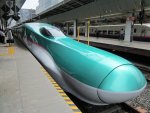Leadfoot866
Well-Known Member
- Joined
- Nov 2, 2007
- Messages
- 1,429
- Location
- Southwestern PA
- Car(s)
- '12 Ford Focus hatch, '06 Nissan Sentra sedan
If I remember correctly, on US locomotives the dynamic brakes are operable so long as the automatic/train brake is not set to emergency. The independent brakes do not affect the dynamics.
Jumping off a moving train and/or leaving a running locomotive unattended is against regulations here in the States...but it's not unheard of, actually. It's one of those "it's OK so long as you don't get caught" things.
Yes, it would have been better if he had just run the point and have to deal with an angry manager, though I'm thinking there was something else going on with this engineer that would make him take the risk. Either not thinking clearly for personal reasons or he was already in trouble for something else and didn't want another thing against him.
We may never know...
Also, as far as I can tell, there's no regulation against moving a train with the brake line disconnected while within the confines of a rail yard since the speed restrictions are low. As the article pointed out, this is a common "shortcut" used by engineers when performing switching duties. All in the name of getting the job done faster.
Jumping off a moving train and/or leaving a running locomotive unattended is against regulations here in the States...but it's not unheard of, actually. It's one of those "it's OK so long as you don't get caught" things.
Yes, it would have been better if he had just run the point and have to deal with an angry manager, though I'm thinking there was something else going on with this engineer that would make him take the risk. Either not thinking clearly for personal reasons or he was already in trouble for something else and didn't want another thing against him.
We may never know...
Also, as far as I can tell, there's no regulation against moving a train with the brake line disconnected while within the confines of a rail yard since the speed restrictions are low. As the article pointed out, this is a common "shortcut" used by engineers when performing switching duties. All in the name of getting the job done faster.




 obviously at a coal-fired power station with a basically free 24/7 steam supply :lol:
obviously at a coal-fired power station with a basically free 24/7 steam supply :lol: